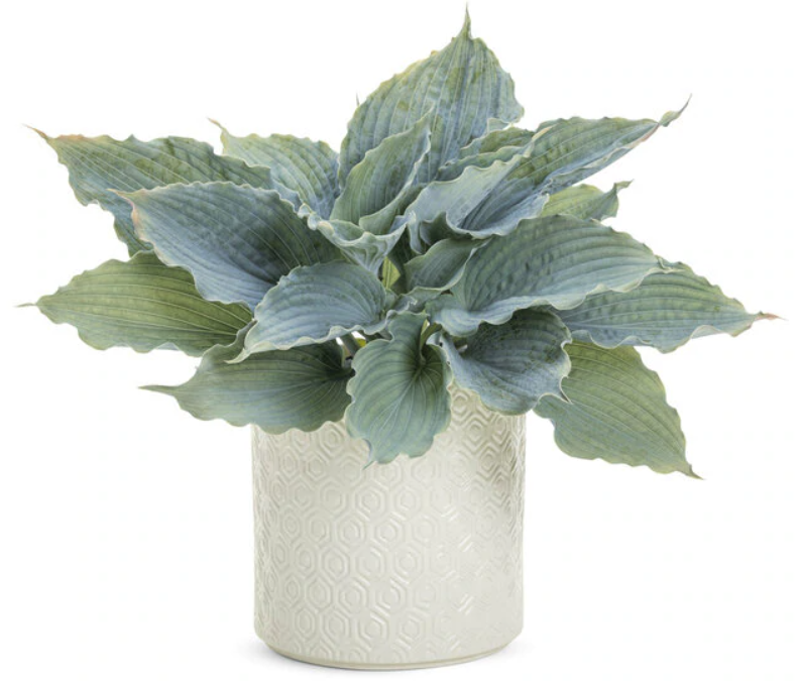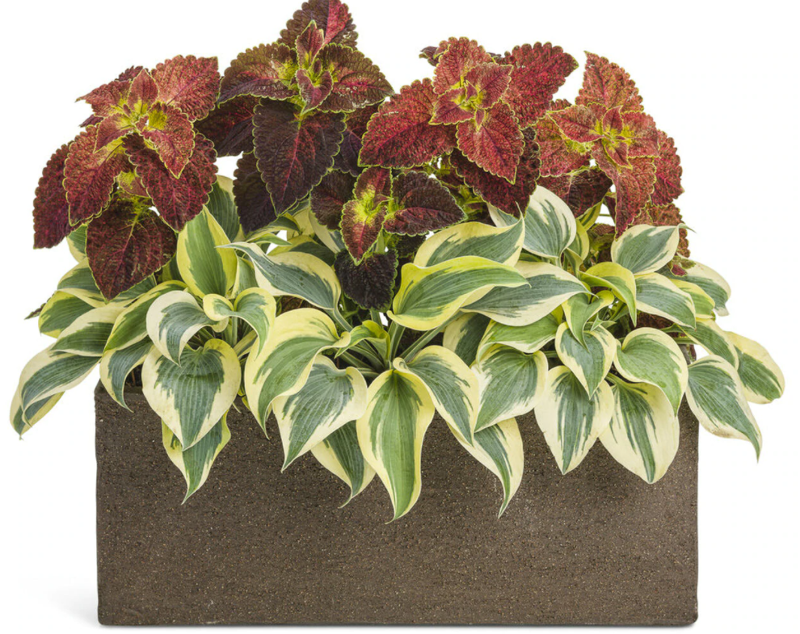Hostas are a very hardy and versatile plant. This perennial grows well in zones 3-9 and needs minimal maintenance. Often considered a shade garden plant, hostas can thrive in containers as well. The many shades of green and yellow in the leaves as well the leaf variations makes a hosta an excellent addition to a balcony, porch, or patio area. If your garden area is prone to slugs, planting a hosta in a container instead would be wise.

Planting Hostas in Pots
Growing hostas in pots is simple. The best time to plant it is in the early spring or early fall before a hard frost. Do not plant it in the heat of the summer. Hostas grow horizontally, so it is recommended that you choose a container that has less than 3 inches of space between the roots and the side of the pot. This will allow space for the roots to grow as the leaves of the hosta spread out.
A smaller pot will keep the hosta healthy and happy. Yes, it will require more watering, so choose a container that has good drainage. We recommend our plastic resin container. This will help prevent root rot. You can also add rocks to the bottom of your container prior to planting to help ensure drainage.
Hostas prefer partial to full shade. It can handle the morning sun, but prefers afternoon/evening shade. If the plant appears stressed, move it to a shadier area to give it a break for the heat, especially during the summer months.
Best Soil For Hostas in Pots
If you are growing your hosta in a pot, it can handle a standard potting soil. You can also plant it in a multi purpose compost or a mixture of potting soil and compost. It will grow best in soil that is fertile and full of organic matter. Compost, ground tree bark, or composted manure are good sources of organic matter. These also aid in drainage, which is important for hostas.
Caring For Hostas in Planters
Hostas need both shade and sun to survive. Depending on your variety of hosta, there may be specific light requirements. Brown on the outside edges of the leaves or a dull color of faded spots on the leaves mean that the hosta is getting too much sun. Here is a hosta that looks very healthy and is blooming in the planter!

Container grown hostas require a lot of water. Water frequently, especially on hot summer days. Keep an eye out that your container is draining regularly. Hostas like moist but not soggy soil.
Frequent watering of potted hostas can cause it to lose much needed nutrients. Use a slow release fertilizer when you pot it, and continue to fertilize every other week.
Watering Hostas in Pots
Hostas growing in containers need to be watered regularly. Water it below the leaf canopy and around the crowns. Too much water on the leaves can leave marks. A thorough drink less frequently is better than a bit of water each day.
During especially hot spells, you may need to water it every day or two. When too dry, hosta leaves will wilt, but they will not die right away. If it is wilting, then it needs a drink. Careful not to saturate your plant, root rot can set in. Good drainage in your container will help prevent this from happening.

Fertilizing Hostas in Pots
Regular fertilizing of hostas is important. Because hostas need regular watering, many nutrients are often washed away. Using a 10-10-10 fertilizer works well. At the least, fertilize your container in the spring and again mid-summer. Otherwise, fertilize every other week. Stop fertilizing 2 months before the anticipated first frost. This will give the plant time to get ready to be dormant. Resume fertilizing when new growth begins again in the spring.
Winter Care For Hostas in Pots
Hostas are perennial plants. They require 6 weeks of below 40 degree temperatures for their dormant period. Once the plant goes dormant, cut the leaves back. Wait until the leaves are no longer green. Cutting the leaves off too early will deplete the winter energy needed for storage.
Once the hosta has gone dormant, store the container in an unheated garage or a shed. Another option is to bury the pot fully in the ground or transplant the hostas in your yard. Steer clear of natural pot materials, like untreated terra-cotta. The material absorbs water which can expand when frozen, resulting in a cracked pot. We recommend our resin plastic container.
Remember to water the hosta once a month during the winter. It is important that the hosta has it’s cold dormant period. So, do not bring it inside as a houseplant.
Can Hostas Be Grown Indoors
Hostas are generally thought of as an outdoor garden plant. They can also be nurtured as a houseplant. Start off by choosing a pot that has good drainage. Place the container where it will receive bright, indirect sunlight.
Hostas like generally moist soil, yet not soggy. Water when the soil feels slightly dry. Fertilize every other week with a 10-10-10 fertilizer.
Hostas will still need a dormant time during the winter.
Plan to move the container to a dark area where the temperature remains around 40 degrees but not freezing. Do not allow the plant to dry out. Water lightly once a month. Return the plant to it’s normal spot in the spring.
 |
Author Chris Link - Published 01-04-2021 |
